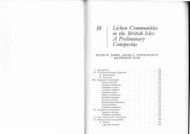You also want an ePaper? Increase the reach of your titles
YUMPU automatically turns print PDFs into web optimized ePapers that Google loves.
paraphysoid: arising before or during the<br />
production <strong>of</strong> asci “tissue”, that through<br />
lengthening becomes similar to an accumulation<br />
<strong>of</strong> pseudoparaphyses, very flaccid and reticulate.<br />
paraplectenchymatous: a ± uniform fungus tissue<br />
consisting <strong>of</strong> rounded-multiangular, non<br />
elongated cells, resembling the parenchyma <strong>of</strong><br />
higher plants.<br />
parasymbiont: in lichenology: an additional<br />
fungus partner in the lichen symbiosis, living at<br />
the expense <strong>of</strong> the photobionts, but in contrast to<br />
a parasite not clearly damaging.<br />
periphyses: in the case <strong>of</strong> perithecia: true<br />
filamentous hyphae in the ostiole region.<br />
periphysoids: in the case <strong>of</strong> perithecia:<br />
filamentous hyphae growing down from near the<br />
tip <strong>of</strong> the ostiole.<br />
perithecium: spherical to pear-form fruiting<br />
body, which opens by a ± central pore, usually ±<br />
strongly sunken into the thallus.<br />
photobiont: the only photosynthesis capable<br />
partner in the symbiosis, i.e. bluegreen or green<br />
algae.<br />
phyllocladium: squamule-like finger-form, corallike<br />
to granular covering <strong>of</strong> fruticose lichens<br />
(above all in the case <strong>of</strong> podetia <strong>of</strong><br />
Stereocaulon).<br />
placoid: ± rosette growing, marginal lobed<br />
crustose lichens (with “radial” arranged<br />
elongated marginal lobes).<br />
plectenchyme: thick tissue <strong>of</strong> fungus hyphae.<br />
podetium (-ia): cup-, peg- to fruticose-form,<br />
usually ± erect part <strong>of</strong> a lichen thallus, apothecia<br />
arise on them (above all in the case <strong>of</strong> Cladonia).<br />
primary thallus (basal thallus): in the case <strong>of</strong><br />
species with a thallus <strong>of</strong> two different parts, the<br />
part spreading over the substrate is the first part<br />
developing.<br />
polar 2-celled, polar diblastic, polarilocular: 2celled<br />
spores with a thick dividing wall, which is<br />
penetrated by a thin canal connecting both cells.<br />
prosoplectenchymatous: fungus tissue made up<br />
<strong>of</strong> elongated cells.<br />
protococcoid = chlorococcoid.<br />
pseudocyphellae: delicate whitish points or<br />
(<strong>of</strong>ten branching) streaks or flecks, breaking<br />
through the cortex, used for air exchange.<br />
pseudoparenchyma = paraplectenchyma.<br />
pseudopodetia: podetia-like shrubby to peg-like<br />
structures in the case <strong>of</strong> Stereocaulon.<br />
pycnidium -ia: organ, in the asexual spore<br />
production (pycnospores), usually small point-<br />
like and sunken in the thallus, rarely projecting<br />
wart-form to cylindrical, in the interior with<br />
mostly spherical or pear-form lumen.<br />
pycnospores (conidia): asexual reproductive<br />
parts produced in the pycnidia.<br />
pyrenocarp (pyrenocarpous): lichens with<br />
perithecia as fruiting bodies.<br />
marginal soralia = border soralia.<br />
rhizine: hyphae producing grasping or bunches <strong>of</strong><br />
grasping, simple or branched (structures), usually<br />
used in attaching the lichen thallus.<br />
rind (cortex): the outer delimiting layer <strong>of</strong> thick<br />
backed fungus hyphae.<br />
disk: upper surface <strong>of</strong> the hymenium in the case<br />
<strong>of</strong> apothecia.<br />
scheitel (apex): the visible part <strong>of</strong> the<br />
perithecium.<br />
schizidium: squamulose-like outermost layers <strong>of</strong><br />
lichen thallus which peel <strong>of</strong>f or loosen as<br />
diaspores.<br />
slime envelop (gelatinous sheet, perispore):<br />
envelop <strong>of</strong> slime or gelatin-like substance around<br />
spores and asci.<br />
secondary thallus (vertical thallus): in the case<br />
<strong>of</strong> species (e.g. Cladonia and Stereocaulon) with<br />
one thallus <strong>of</strong> two different parts which consist <strong>of</strong><br />
the primary thallus and the ± vertical oriented<br />
part.<br />
septum: dividing wall.<br />
sceleroplectenchyma: plectenchyma <strong>of</strong> very<br />
thick-walled, cemented hyphae.<br />
soralium -ia: delimited dusty-granular structure<br />
(thallus eruption), that develops soredia.<br />
soredia: small, ± spherical granules used in<br />
vegetative reproduction (diaspores), which<br />
consist <strong>of</strong> a clump <strong>of</strong> algae surrounded by a web<br />
<strong>of</strong> hyphae.<br />
sorediate: with soredia.<br />
fissure soralia: soralia consisting <strong>of</strong> a streak or<br />
fissure-form crack in the thallus upper surface.<br />
sporodochia: pillow form, apothecia-like<br />
structure that produces pycnospores.<br />
peg-form: narrow cylindrical.<br />
habitat: the ecological condition <strong>of</strong> a growth type<br />
(e.g. sunny boulder, deep cracked bark, cold<br />
collecting basin); not to be confused with<br />
“fundort = locality where found”.<br />
stenök: with narrowly delimited habitat region.<br />
strahlig: radially ordered.<br />
fruticose lichen: bushy branched to simple pegform,<br />
erect growing or bushy or beard-form<br />
pendent, usually only attached to the substrate in<br />
a few places.<br />
stylospores: asexual spore-like reproductive<br />
parts, which are produced in pycnidia-like<br />
organs.<br />
31





